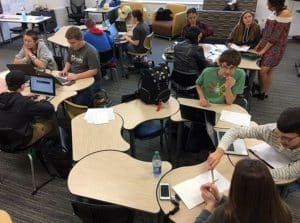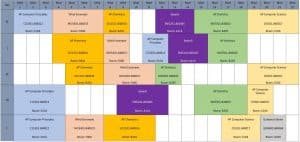Flex-Mod Scheduling to Enable Competency-Based Learning
CompetencyWorks Blog
 New approaches to scheduling are an important part of putting high-quality competency-based education into practice. Key elements such as varied pacing, targeted supports for all students, and performance-based assessments can be implemented more effectively with flexible scheduling.
New approaches to scheduling are an important part of putting high-quality competency-based education into practice. Key elements such as varied pacing, targeted supports for all students, and performance-based assessments can be implemented more effectively with flexible scheduling.
This blog post is the first of two that describe the flexible modular or “flex-mod” schedule at Legacy High School in Bismarck, North Dakota and their research partnership with REL Central to study how schools can use flexible scheduling effectively. The blog posts are based on an Aurora Institute webinar that featured Tom Schmidt, Principal of Legacy High School; Ben Johnson, Assistant Superintendent of the Bismarck Public Schools; Marc Brodersen and Jeanette Joyce, Senior Researchers at REL Central; and Ben Patton and Isabella Ternes, students at Legacy High School. The high school has 1,380 students.
Legacy’s flex-mod schedule for freshmen is shown below. Each day is a series of 22 periods or “mods,” each 20 minutes long. The mods can be assembled to create class meetings of different durations. Looking at the Monday schedule, you’ll see that Algebra meets for two mods (40 minutes), Spanish for three mods (60 minutes), and Global Studies for four mods (80 minutes). A given course can also have different class meetings of different durations, such as algebra, which meets for two, three, or four mods on different days.

This schedule also enables classes to meet in different configurations. Each Global Studies section, for example, meets three times per week for 40, 80, and 80 minutes. In addition, all of the Global Studies sections, 346 students in total, meet weekly as a large group for 40 minutes in the auditorium. The combined class is used for guest speakers, assessments, writing activities, and whole-group lectures. It also provides some time efficiencies for material that the teachers judge can be presented effectively to the whole group at once.
As any teacher knows, partway through a typical class meeting, many students have already finished the assessment or mastered the new material introduced during that day’s class. With the flex-mod schedule, teachers can dismiss those students for the final one or two mods, while the remaining students complete the assessment or get one-on-one or small-group support from the teacher. This enables both the early completers and the remaining students to spend their time more efficiently and get more of what they need. Alternatively, teachers can have students who need extra support come to the first mod of a longer block, with other students arriving later.

Students who are dismissed early or have flex time on their calendars—the white spaces in the image above—have various options. Legacy High School has “Saber Centers” (named for their school mascot, the saber-toothed tiger), where students can go to work independently or with other students and receive support from teachers. The three Saber Centers are focused on STEM, humanities, and art. Each one is staffed throughout the day by teachers who have expertise in those areas. Students of all grade levels can use a given Saber Center at the same time.
Another advantage of Saber Centers, Johnson said, is that students get to work with and develop relationships with more teachers. Some are teachers the student has worked with in previous grades. Others they will have in future grades but will already have a relationship with due to the Saber Center work. Johnson said this dynamic accelerates students’ learning and also helps build the staff’s sense of collective responsibility to move all students forward—seeing all students as “our” students rather than “their” students.
Students can also use flex time to spend extra time in another classroom, such as completing work in the art studio or a physics lab. Or they can go to the library, work out in the weight room, schedule a music lesson or personal tutoring, take a jog, or have lunch. Sometimes it’s possible for students who have been out sick or have a scheduled absence to use their flex time to attend a different meeting of the same class that’s covering the material they missed. As students move into higher grade levels, they have more flex time in their schedules and are more likely to use it to leave the building for job shadows, internships, medical appointments, and other commitments. One student’s senior schedule is shown below.

Why Flex-Mod Scheduling?
Principal Tom Schmidt explained that traditional schedules had often been obstacles to increasing student agency, personalization, and development of skills such as collaboration, communication, and self-direction that the school considers essential to preparing students for the complex demands of work and life. The school had met with colleges who reported that students’ underdeveloped self-direction and time management skills were far greater obstacles to success than their academic readiness. Part of the rationale for the flex-mod schedule is that it helps students get more experience with managing their time.
“There are freshmen in college who have never been taught how to use their free time,” Schmidt said. “We keep kids under lock and key for 12 or 13 years of their life, with a bell schedule and monitors walking the hallways, and then three months after graduation we turn them loose on a college campus and say ‘Go be successful.’ And then when they’re not, we blame them and not ourselves. So we have to create opportunities for kids to fail, so when they go out of our doors they can make the right decisions.”
Schmidt emphasizes that flex-mod scheduling was not a top-down mandate. The school began implementing it six years ago when Schmidt asked teachers what type of schedule would be best for helping students learn. Some teachers wanted shorter periods that met more times per week. Others wanted longer periods that met fewer times per week. Some teachers wanted to work with smaller groups of students, and others wanted the efficiency of presenting fewer times to larger groups.
The teachers were decribing a flex-mod schedule without using those words, so Schmidt created a first draft of the schedule to try out for 90 days. During that time, staff could put any comments and concerns on a feedback board. Urgent concerns could be addressed immediately, and others would be addressed after 90 days. What actually happened, Schmidt said, was that teachers kept sharing their own solutions to their colleagues’ concerns, either informally or during a professional learning day devoted to this topic. By the end of the 90 days, all the posted concerns had been addressed, so the school continued with the new schedule and continued making incremental changes over time.
One urgent change was after the first day, when some mods had been scheduled as flex time for every student in the school. It was chaotic, and the schedule was quickly changed so flex time was more staggered. Another concern was that freshmen were given too much flex time and weren’t using it wisely, so the school reduced the number of mods of flex time per week for freshmen. They also created an advisory program, and an important part of freshman advisory was discussing how to manage independent time effectively. “Advisory was a savior,” Schmidt said. “We had to teach students [how to manage their time], because they’d never been taught it before.”
Johnson and Schmidt said that teachers like the flex-mod schedule, noting that none have requested a transfer out of the school since it started, and many from other schools in the district have requested a transfer in. Veteran teachers have told Johnson that if the school goes back to traditional scheduling, they will quit. (This was in contrast to newer teachers, who have never experienced traditional scheduling.) He also mentioned that teachers appreciate the greater flexibility the new schedule provides for using the bathroom, an under-recognized but serious issue.
Students Patton and Ternes also said they like the flex-mod schedule. Patton appreciates how the flex time allows him to catch up on missed work or labs, do homework, and get help from teachers in the Saber Centers. Ternes is a senior with many extracurricular activities, and the schedule enables her to get much of her homework done during the school day. She’s also an artist and the art Saber Center allows her ample time to work on her art projects. (Johnson mentioned that more students at Legacy High School take art and music courses than at other schools in the district, because the flex-mod schedule allows them to take more classes total and doesn’t force them to choose between AP classes and art or music classes.)
Flex-Mod Scheduling and Hybrid/Remote Learning
The pandemic fully shut down the Bismarck Schools in the spring, but the buildings are open now and following the flex-mod schedule. Students whose last names start with A through K attend school in person on the two “A” days per week, the remaining students attend in person on the two “B” days per week, and students who are scoring below 70% in any of their classes attend in person on the one “C” day per week. Teachers offer some synchronous activities that students working off-site are expected to log into. Other activities are asynchronous and don’t have that expectation. Teachers in the Saber Centers support students both remotely and in person.
The next blog post describes the research partnership between Legacy High School and REL Central and what they have learned about how students are using their independent time.
Learn More
- Lessons from Tracking Student Flex Time in a Competency-Based High School
- Diversifying the Student Body and Personalizing Student Schedules at NYC iSchool
- Innovative Scheduling: Digital e-Learning Days and Academic Support Periods
- Scheduling for Personalized, Competency-Based Education
Eliot Levine is the Aurora Institute’s Research Director and leads CompetencyWorks.